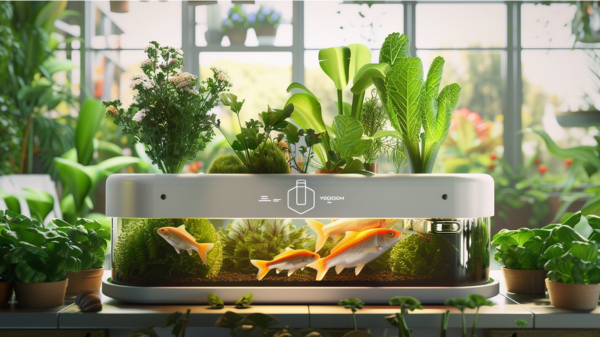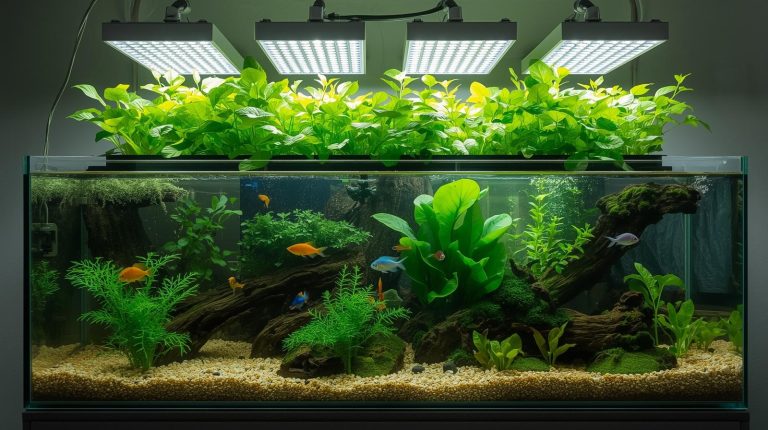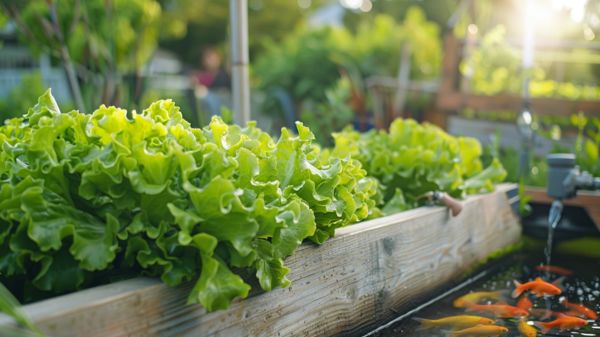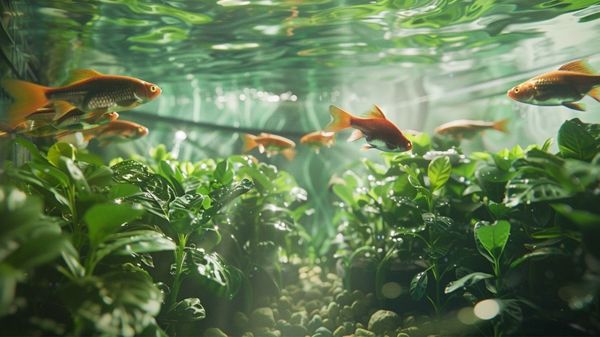Embarking on an aquaponics journey is akin to unlocking a treasure chest brimming with sustainable riches. You’re about to explore a world where fish and plants live in mutual benefit, creating a harmonious ecosystem right in your backyard. This guide serves as your map, illuminating the path from the basics of setting up your aquaponics system to the more intricate details of maintaining a flourishing garden.
But before you can reap the rewards of your self-sustaining oasis, there’s a crucial first step you need to take. Curiosity may have killed the cat, but in aquaponics, it’s the key to unlocking endless possibilities.
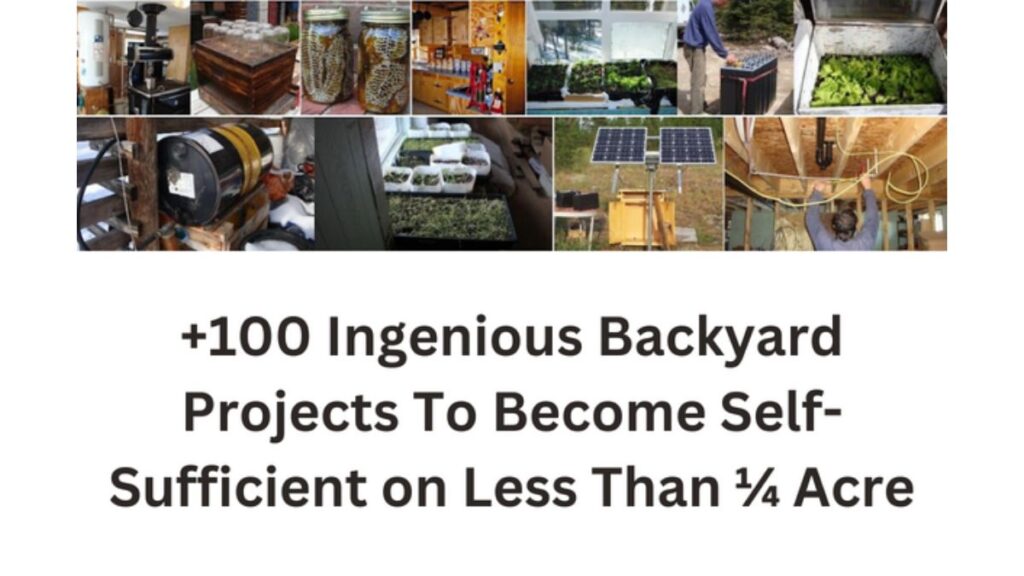
>>> CLICK HERE TO LEARN MORE <<<
Key Takeaways
- Aquaponics combines aquaculture and hydroponics, recycling fish waste into plant nutrients.
- It uses up to 90% less water than traditional farming methods.
- Suitable for year-round production, it enables the growth of a variety of plants and fish.
- Essential components include a fish tank, grow bed, water pump, and air pump for system setup.
Understanding Aquaponics
At its core, aquaponics merges aquaculture and hydroponics into a sustainable, symbiotic system for efficient food production. It allows you to garden year-round with significantly less water than traditional methods require.
This system ingeniously combines the nurturing of fish with the cultivation of plants, creating a self-sustaining environment. Fish waste provides nutrients for the plants, and in return, the plants purify the water for the fish.
Various types of aquaponics systems, including the Nutrient Film Technique, Raft System, and Media Based System, offer flexibility to adapt to your space and budget constraints. Whether you’re setting up a small indoor unit or scaling up for commercial production, understanding these components and the roles they play is crucial.
It’s a revolutionary approach that empowers you to produce food sustainably.
How Aquaponics Works
Understanding how aquaponics functions begins with recognizing the symbiotic relationship between fish and plants. Bacteria play a crucial role in converting fish waste into vital nutrients for the plants, purifying the water in a closed-loop system.
This innovative approach leverages the nitrogen cycle, where beneficial bacteria break down fish waste, transforming ammonia into nitrates for plant consumption.
It is a sustainable method that mimics nature’s balanced ecosystems, promoting the health and growth of fish and plant life without the need for chemical fertilizers or pesticides.
Benefits of Aquaponics
Aquaponics revolutionizes traditional farming by using up to 90% less water, making it a highly resource-efficient method for growing fresh and nutritious food. Here are three key benefits:
- Sustainability: Aquaponics is a beacon of sustainable agriculture. Its closed-loop system recycles water efficiently, dramatically reducing the need for chemical inputs and preserving vital water resources.
- Year-Round Production: You’re not bound by seasons. Aquaponics enables the growth of fish and plants together in a small space, ensuring a continuous supply of fresh produce and fish, irrespective of the external climate.
- Chemical-Free Crops: In this system, plants thrive on natural fish waste, eliminating the necessity for harmful pesticides or fertilizers. This method not only yields high-quality produce but also protects your health and the environment.
Preparing to Start
Before diving into the construction of your aquaponics system, you’ll need to assess the space, water, and electrical requirements to ensure its feasibility and sustainability. Gauge the area needed by considering the sizes of the fish tank and grow bed.
Water requirements hinge not only on system size but also on the types of fish and plants you plan to culture. Speaking of fish, research which types thrive in your climate and match your system’s specifics. Remember, every element from lighting to temperature control impacts your aquaponics system’s success.
Don’t overlook the initial setup cost alongside ongoing maintenance expenses. This preparatory phase is crucial, setting the foundation for a thriving aquaponics system that meets your aspirations for self-sufficiency and environmental stewardship.
Choosing the Right Location
Selecting the right location for your aquaponics system requires careful consideration of several critical factors to ensure optimal plant growth and system efficiency. Here are three key points to visualize:
- Natural Light: Your setup must bask in ample natural light, essential for your plants to thrive. Positioning is crucial; ensure the chosen spot receives consistent daylight.
- Water Source Proximity: Ease of access to a water source simplifies maintenance, allowing you to manage the system’s hydration needs without hassle.
- Proper Ventilation: A well-ventilated area ensures air quality and temperature remain stable, essential for both plant and aquatic life.
System Design Options
When exploring the realm of aquaponics, you’ll find several design options, each catering to different needs and scales of operation.
| System Type | Description |
|---|---|
| Media-based Systems | Utilize inert media, like clay pellets, to support plant growth. Ideal for beginners due to simplicity. |
| Raft Systems | Involve floating plants on a raft above water, allowing roots direct nutrient access. |
| Nutrient Film Technique (NFT) | Employs a shallow stream of nutrient-rich water, exposing roots to oxygen. |
Hybrid systems cleverly combine techniques to maximize efficiency, producing a diverse range of crops. Each system has its unique benefits, whether you’re just starting or scaling up. Choosing the right aquaponics system involves considering your space, the crops you wish to grow, and your commitment to maintenance.
Essential System Components
To set up a successful aquaponics system, you’ll need several key components, including a fish tank, grow bed, water pump, air pump, and an efficient plumbing system. These elements work in synergy to create a sustainable environment where fish and plants flourish together.
Here’s a quick glimpse into the essentials:
- Fish Tank: Your aquatic pets’ home, pivotal for the aquaponics system as it’s the primary source of nutrients for the plants.
- Grow Bed: This is where your plants will reside, extracting nutrients from the water, which, in turn, purifies it for the fish.
- Water Pump and Plumbing System: They ensure a continuous flow of water between the fish tank and grow bed, while the air pump oxygenates the water, essential for both fish and plant health.
Related Post: Aquaponics Fish Tank – How To Get The Right and Perfect Design.
Selecting Fish for Aquaponics
Having covered the essential components necessary for setting up your aquaponics system, it’s crucial to focus on the right types of fish that’ll thrive in this environment and support plant growth. Selecting appropriate fish species involves considering growth rates and environmental requirements to ensure a harmonious ecosystem.
Popular choices like Tilapia, Catfish, Trout, Koi, and Goldfish are favored for their adaptability and robust growth potential. It’s essential to choose fish with similar temperature and pH preferences, maintaining a balanced ecosystem. Additionally, proper feeding schedules and meticulous attention to water quality are paramount for the health of your fish and the productivity of your system.
Carefully selecting fish based on local availability, legal considerations, and their compatibility with your system’s plants is crucial for a successful aquaponics setup.
Recommended Plants
Selecting the right plants for your aquaponics system is crucial, as certain species like lettuce, kale, and spinach thrive due to their rapid growth and specific nutrient needs. In aquaponics systems, these leafy greens absorb nutrients efficiently, making them ideal for beginners.
Consider incorporating these plants:
- Herbs such as basil, mint, and cilantro, which not only enhance your culinary creations but also flourish in the nutrient-rich water of aquaponics systems.
- Tomatoes and bell peppers offer high nutritional value and versatility in dishes, requiring a bit more care but rewarding you with bountiful harvests.
- Cucumbers, perfect for refreshing salads, thrive in these systems, providing a versatile vegetable option.
Choosing plants that match your system’s capabilities ensures a thriving aquaponic garden.
Setting Up Your System
Initiating your aquaponics system begins with choosing an optimal location that ensures sufficient light, water access, and proper ventilation. You’ll need to select the right system type for your goals, whether it’s media-based, a raft system, NFT, or a hybrid approach. Each type responds differently to environmental factors such as humidity and lighting, which are crucial for your system’s success.
Ensure your system’s components, including the fish tank, grow bed, water pump, air pump, tubing, and fittings, are aligned with your chosen system type. Consider both DIY options and pre-made systems to find the most efficient setup for your needs. Remember, the balance between these components and the environmental factors surrounding your aquaponics system is key to creating a thriving ecosystem.
Cycling and Bacteria
After setting up your system with the right components and environmental conditions, it’s crucial to focus on cycling and bacteria to ensure your aquaponics ecosystem thrives. Cycling, the process of establishing beneficial bacteria populations, is fundamental. These microorganisms convert fish waste (ammonia) into plant-ready nutrients (nitrate), a process taking 4-6 weeks to stabilize.
Here’s what you need to keep an eye on:
- Ammonia levels: Originating from fish waste, too high can be toxic.
- Nitrite conversion: A halfway point, nitrites must be quickly converted as they’re also harmful.
- Nitrate production: The end goal, nitrates feed your plants, closing the loop.
Monitoring these levels is crucial, ensuring a thriving aquaponics system where beneficial bacteria support healthy plant and fish life.
System Maintenance Basics
Regularly monitoring pH, ammonia, nitrite, and nitrate levels is crucial for maintaining water quality in your aquaponics system. By keeping these parameters in check, you’re not just ensuring the health of your fish but also promoting optimal plant growth.
System maintenance doesn’t stop there. You’ve got to establish a balanced feeding schedule for the fish. Overfeeding can deteriorate water quality, while underfeeding affects their health and the system’s nutrient cycle.
Moreover, pruning your plants and addressing pest issues promptly prevents the spread of disease and keeps your system running smoothly. Troubleshooting common issues like nutrient imbalances and fish health problems early on is essential.
Don’t hesitate to seek help from online communities, local experts, or educational resources. They can offer invaluable guidance on maintaining your aquaponics system efficiently.
Monitoring Water Quality
Moving from the basics of system maintenance, it’s crucial to focus on monitoring water quality to ensure your aquaponics system thrives. Regular vigilance in testing and adjusting water quality parameters liberates your system from potential hazards, ensuring a harmonious balance for both fish and plants. Here’s how:
- pH Levels: Aim to keep the pH between 6.8 to 7.0. This range is optimal for plant absorption and fish health.
- Ammonia Levels: Use water testing kits to ensure ammonia levels are below 1 ppm. High ammonia is toxic and can compromise the system’s balance.
- Nitrite Levels: Keep nitrite levels under 0.5 ppm to prevent stress and ensure the vitality of your aquaponics environment.
Properly monitoring and adjusting these water quality parameters is essential for the flourishing of your aquaponics system.
Fish Health and Feeding
Ensuring your fish receive balanced nutrition through 2-3 feedings per day is pivotal to maintaining their health and the overall success of your aquaponics system. Proper feeding practices are crucial; too much food can spike ammonia levels, while too little can stunt growth, disrupting your system’s harmony.
You’ll need to keep an eagle eye on water parameters, including pH, ammonia, nitrite, and nitrate levels, as these indicate your system’s health and your fish’s well-being. Monitoring behavior and appearance offers early warning signs of distress.
Should you notice uneaten food, remove it promptly to prevent water contamination. Adhering to these guidelines ensures your fish thrive, safeguarding your aquaponics system’s balance and productivity.

>>> CLICK HERE TO LEARN MORE <<<
Managing Aquaponic Plants
After focusing on fish health and feeding, it’s crucial to turn our attention to the plants in your aquaponics system, which thrive on the nutrients provided by fish waste. Here’s how you can manage your aquaponic plants for optimal health and productivity:
- Prune Plants Regularly: Pruning encourages robust plant growth and prevents overcrowding. It ensures every plant gets its fair share of light and air, critical for photosynthesis and respiration.
- Monitor pH and Nutrients: Maintaining proper pH levels and nutrient balance is essential. Beneficial bacteria convert fish waste into nutrients, but you must regularly test water to ensure plant growth isn’t hindered.
- Leverage Plants’ Filtering Capability: Aquaponic plants play a vital role in filtering water, making the environment healthier for fish. This symbiotic relationship underscores the beauty of aquaponics, where you’re not just growing plants but nurturing an entire ecosystem.
Troubleshooting Common Issues
How do you tackle the common issues that can arise in your aquaponics system, such as pests, disease, and algae growth? It’s crucial to monitor your setup closely and act swiftly to mitigate these challenges. Employing natural pest control methods ensures a sustainable approach to managing infestations, preserving the delicate balance of your ecosystem.
| Issue | Solution | Benefit |
|---|---|---|
| Pests | Natural predators | Reduces chemical use |
| Algae | Adjust light exposure | Maintains water quality |
| pH Imbalance | Regular testing & adjustment | Optimal plant and fish health |
Adjusting water quality parameters is key. Regular testing of pH, ammonia, and nitrate levels helps prevent issues that could compromise your system’s health. Keep an eye on these critical indicators to ensure your aquaponics system thrives.
Expanding Your System
Expanding your aquaponics system requires careful planning to accommodate the increased needs for space, water, and energy efficiently. As you embrace the challenge, remember that scaling up means more than just enlarging your setup; it’s about enhancing your system’s productivity while maintaining stability.
To navigate the complexities of expansion, consider the following steps:
- Gradually Increase Capacity: Scale your system bit by bit to meet the increased demands without compromising system stability.
- Innovate for Growth: Test new growing methods and species to optimize growth and diversify your output.
- Adapt and Learn: Tailor your expanded system to your specific environment, learning from any setbacks to improve efficiency and productivity.
DIY Aquaponics Designs
Building on the concepts of system expansion, crafting a DIY aquaponics design allows for personalization that aligns with your specific requirements, including space, budget, and desired output. By embracing DIY aquaponics systems, you’re not just setting up a system; you’re adopting a sustainable method to grow your fish and plants together. This approach is not only cost-effective but also provides a rich learning experience.
| System Type | Key Features |
|---|---|
| Media-Based | Uses grow media to support plant roots; versatile. |
| Nutrient Film Technique (NFT) | Thin film of water recirculates, ideal for leafy greens. |
| Raft | Plants float on water surface; efficient for large setups. |
| Vertical | Saves space; suitable for herbs and small vegetables. |
Choosing the right DIY design ensures a harmonious balance between your fish and plants, maximizing your system’s output while minimizing waste.
Aquaponics and Permaculture
Integrating aquaponics with permaculture principles can significantly boost your system’s efficiency and sustainability. By adopting this holistic approach, you’re not just growing food; you’re cultivating a resilient ecosystem that thrives on minimal external input.
Permaculture’s emphasis on natural processes and resource optimization perfectly complements the closed-loop system of aquaponics, where waste from fish becomes a nutrient source for plants, and in turn, plants purify the water for the fish.
Consider these three key benefits:
- Resource Optimization: Maximize water and nutrient use, dramatically cutting waste.
- Ecosystem Design: Craft a self-regulating environment that mimics natural ecologies.
- Sustainability: Establish a system that sustains itself and reduce the need for chemical inputs and fostering a healthier ecosystem.
Embracing permaculture principles in your aquaponics setup empowers you to build a more productive, efficient, and sustainable system.
Making Money With Aquaponics
Venturing into aquaponics offers a unique opportunity to generate revenue through various channels. This includes the sale of fresh produce and fish, educational workshops, and system maintenance services.
By hosting aquaponics workshops and educational programs, you’re not just sharing knowledge but also establishing a revenue stream that capitalizes on the growing interest in sustainable farming. Selling aquaponics system kits provides a direct route to those eager to start their journey, offering both initial setup and ongoing support.
Maintenance services ensure your expertise remains in demand, keeping systems running efficiently for clients. Additionally, creating farm-to-table experiences can transform your operation into a destination, attracting visitors keen on understanding and participating in the cycle of food production.
These avenues not only diversify your income but also strengthen the aquaponics community.
Frequently Asked Questions
What Is the Best Aquaponic System for Beginners?
You’re likely wondering about the best aquaponic system to start with. The media bed system’s your answer. Its simplicity, low maintenance, and cost-effectiveness make it ideal, supporting a wide variety of plants easily.
How Do I Get Started in Aquaponics?
To get started in aquaponics, choose a spot with good light and water access. Decide on DIY or a pre-made kit based on your budget. Consider environmental factors and gather essential components like tanks and pumps.
What Are the Basics of Aquaponics?
You’re seeking freedom from traditional gardening woes; aquaponics offers that escape. Merge fish farming and plant cultivation, recycling fish waste as plant nourishment for a sustainable, space-saving food production system.
What Is the Best Beginner Fish for Aquaponics?
You’re looking for the best beginner fish for your aquaponics system, right? Consider tilapia. They’re hardy, grow quickly, and are quite forgiving for beginners. Plus, they’ll thrive in a variety of aquaponic setups.
Conclusion
As you’ve now journeyed through the verdant world of aquaponics, armed with the knowledge to weave water and earth into a symphony of sustainability, your green thumb has evolved into an alchemist’s wand.
By choosing the perfect spot, embracing permaculture, and even monetizing your lush oasis, you’re not just growing plants and fish; you’re cultivating a future where food is as boundless as your imagination.
Remember, in the realm of aquaponics, every drop of water is a universe of possibility.

